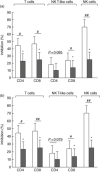Lung cancer is associated with decreased expression of perforin, granzyme B and interferon (IFN)-γ by infiltrating lung tissue T cells, natural killer (NK) T-like and NK cells
- PMID: 24894428
- PMCID: PMC4360197
- DOI: 10.1111/cei.12392
Lung cancer is associated with decreased expression of perforin, granzyme B and interferon (IFN)-γ by infiltrating lung tissue T cells, natural killer (NK) T-like and NK cells
Abstract
There is a limited understanding how of lung cancer cells evade cytotoxic attack. Previously, we have shown reduced production of the cytotoxic mediator granzyme B by CD8(+) T cells in lung cancer tissue. We hypothesized that lung cancer would be further associated with decreased production of granzyme B, perforin and proinflammatory cytokines by other cytotoxic lymphocytes, natural killer (NK) T-like and NK cells, and that this would result from soluble mediators released by the cancer cells. Lung cancer and non-cancer tissue from five patients was identified by experienced pathologists. Tumour necrosis factor (TNF)-α, interferon (IFN)-γ, granzyme B and perforin were measured in CD4 and CD8(+) T, NK T-like cells and NK cells by flow cytometry. Correlation between cancer stage and granzyme B was analysed retrospectively for 21 patients. The effects of soluble factors released by lung cancer cells on production of cytotoxic mediators and cytokines was assessed, and the role of prostaglandin E2 (PGE)2 /COX investigated using indomethacin inhibition. There were significantly decreased percentages of T, NK T-like and NK cells expressing perforin, TNF-α and IFN-γ in cancer versus non-cancer tissue, and of CD8(+) T cells and CD8(+) NK T-like cells expressing granzyme B (e.g. NK T-like cells: non-cancer 30% ± 7 versus cancer 6% ± 2·5). Cancer cells released soluble factors that inhibited granzyme B, perforin and IFN-γ production that was partially associated with the PGE2 /COX2 pathway. Thus, lung cancer is associated with decreased expression of granzyme B, perforin and IFN-γ by infiltrating T cells, NK T-like and NK cells, possibly as a result of soluble factors produced by the cancer cells including PGE2 . This may be an important immune evasion mechanism.
Keywords: NK and NK T-like cells; cytotoxicity; granzyme B; interferon gamma; lung cancer.
© 2014 British Society for Immunology.
Figures




Similar articles
-
Bronchiolitis obliterans syndrome is associated with increased peripheral blood natural killer and natural killer T-like granzymes, perforin, and T-helper-type 1 pro-inflammatory cytokines.J Heart Lung Transplant. 2012 Aug;31(8):888-95. doi: 10.1016/j.healun.2012.04.007. J Heart Lung Transplant. 2012. PMID: 22759800
-
Cytotoxic Function and Cytokine Production of Natural Killer Cells and Natural Killer T-Like Cells in Systemic Lupus Erythematosis Regulation with Interleukin-15.Mediators Inflamm. 2019 Mar 31;2019:4236562. doi: 10.1155/2019/4236562. eCollection 2019. Mediators Inflamm. 2019. PMID: 31049024 Free PMC article.
-
The expression of cytotoxic mediators is altered in mononuclear cells of patients with melanoma and increased by interferon-alpha treatment.Br J Dermatol. 2005 Apr;152(4):690-6. doi: 10.1111/j.1365-2133.2005.06512.x. Br J Dermatol. 2005. PMID: 15840100
-
Reassessing granzyme B: unveiling perforin-independent versatility in immune responses and therapeutic potentials.Front Immunol. 2024 May 23;15:1392535. doi: 10.3389/fimmu.2024.1392535. eCollection 2024. Front Immunol. 2024. PMID: 38846935 Free PMC article. Review.
-
CD8+ T Cell Biology in Cytokine Storm Syndromes.Adv Exp Med Biol. 2024;1448:129-144. doi: 10.1007/978-3-031-59815-9_10. Adv Exp Med Biol. 2024. PMID: 39117812 Review.
Cited by
-
Granzyme B Expression in the Tumor Microenvironment as a Prognostic Biomarker for Patients with Triple-Negative Breast Cancer.Cancers (Basel). 2023 Sep 7;15(18):4456. doi: 10.3390/cancers15184456. Cancers (Basel). 2023. PMID: 37760424 Free PMC article.
-
Innate Lymphoid Cells in Mucosal Immunity.Front Immunol. 2019 May 7;10:861. doi: 10.3389/fimmu.2019.00861. eCollection 2019. Front Immunol. 2019. PMID: 31134050 Free PMC article. Review.
-
Cellular and molecular immunology of lung cancer: therapeutic implications.Expert Rev Clin Immunol. 2014 Dec;10(12):1711-30. doi: 10.1586/1744666X.2014.975692. Epub 2014 Oct 28. Expert Rev Clin Immunol. 2014. PMID: 25351434 Free PMC article. Review.
-
Salmonella-Based Therapy Targeting Indoleamine 2,3-Dioxygenase Restructures the Immune Contexture to Improve Checkpoint Blockade Efficacy.Biomedicines. 2020 Dec 16;8(12):617. doi: 10.3390/biomedicines8120617. Biomedicines. 2020. PMID: 33339195 Free PMC article.
-
Where lung cancer and tuberculosis intersect: recent advances.Front Immunol. 2025 Apr 2;16:1561719. doi: 10.3389/fimmu.2025.1561719. eCollection 2025. Front Immunol. 2025. PMID: 40242762 Free PMC article. Review.
References
-
- Tockman M, Anthonisen NR, Wright EC, Donithang G. Airways obstruction and the risk for lung cancer. Ann Intern Med. 1987;106:512–518. - PubMed
-
- Skillrud D. COPD: causes, treatment, and risk for lung cancer. Compr Ther. 1986;12:13–16. - PubMed
-
- Dehle FC, Mukaro VR, Jurisevic C, et al. Defective efferocytosis in patients with lung cancer with or without COPD – mediated by PGE2 produced by lung cancer cells? PLOS ONE. 2013;8:e61573. . Available at: http://dx.plos.org/10.1371/journal.pone.0061573 (accessed 26 April 2013) - DOI - PMC - PubMed
Publication types
MeSH terms
Substances
LinkOut - more resources
Full Text Sources
Other Literature Sources
Medical
Research Materials

